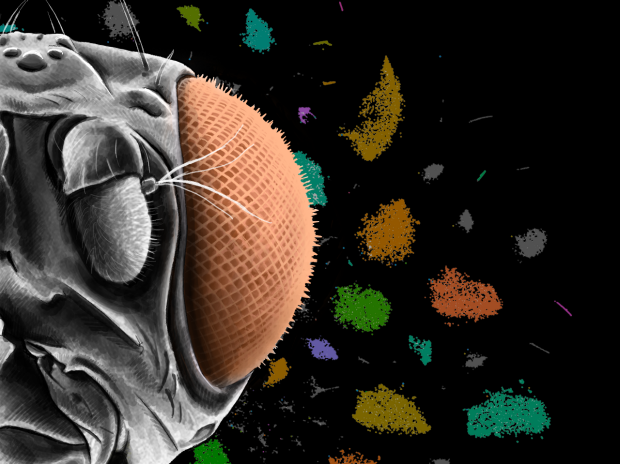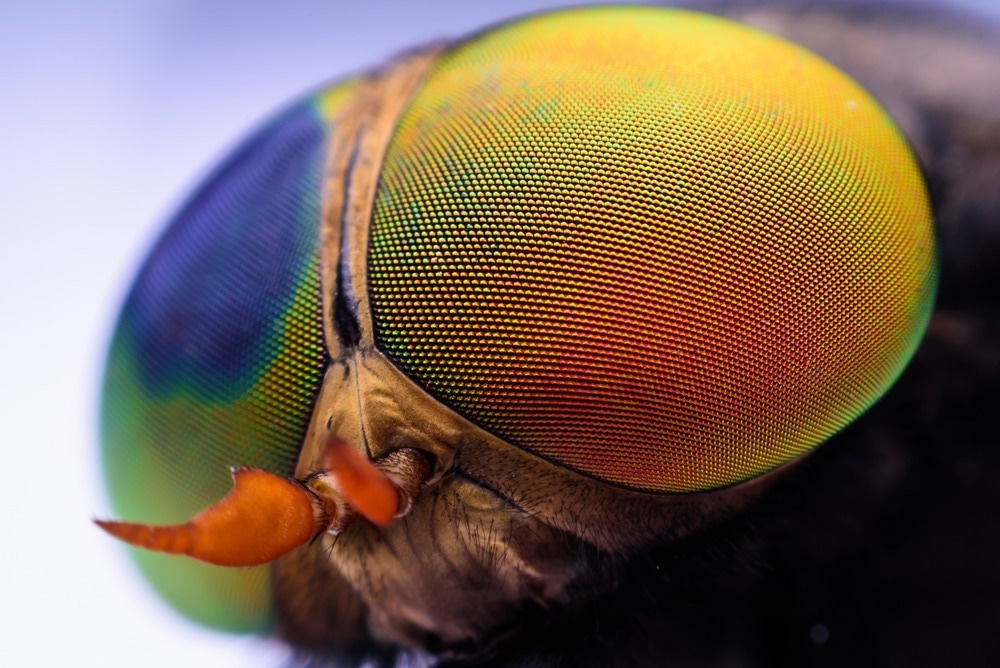Reviewed by Danielle Ellis, B.Sc.Aug 1 2023
Researchers from New York University have created a method that discovers and labels neurons throughout development, which has allowed them to identify novel cell types in the visual system of flies.
 Depiction of a fruit fly head and the clusters of single-cell RNA sequencing of developing visual system. Image Credit: Monika Jasnauskaite
Depiction of a fruit fly head and the clusters of single-cell RNA sequencing of developing visual system. Image Credit: Monika Jasnauskaite
A unique technique and single-cell sequencing data are used in the study, which was published in the journal Proceedings of the National Academy of Sciences (PNAS), to find gene pairs pointing to previously unidentified cells in fruit fly brains.
Fruit flies, commonly known as Drosophila, have long served as a model organism for research on fundamental issues relating to brain growth and function. Fruit flies contain 100,000 neurons as opposed to the 86 billion neurons present in humans, which makes studying the brain a more attainable but nonetheless challenging task.

Image Credit: Komsan Loonprom/Shutterstock.com
The study of neural circuits in the brain has been revolutionized by the use of genetic methods that can discriminate between various cell types in fruit flies. This has enabled researchers to get a detailed understanding of circuit formation, function, and behavior.
A hallmark of the central nervous system is the diversity of different cell types that are responsible for so many different functions.”
Claude Desplan, Study Senior Author and Professor, Biology and Neural Science, New York University
Desplan’s lab has previously utilized single-cell sequencing to estimate the number of cell types in the developing fly’s visual system to be about 200. Gene expression is revealed by single-cell sequencing, therefore cells with similar gene expression patterns are probably carrying out the same function and are, therefore, of the same cell type.
Approximately half of the 200 cell types in the developing fly’s visual system could be identified by scientists based on their gene expression and previous research, but the remaining 100 cell types remained difficult to analyze and label.
Tools already in existence that enabled precise manipulation of adult fruit fly neural circuits frequently failed to identify the same neurons during development, making them useless for studying neurons in the developing brain.
Moreover, the previous approach to identifying cell types involves laborious testing of numerous gene candidate combinations. We knew we needed a much more efficient approach to label specific cell types, and were able to tap into the growing amount of single-cell sequencing data that is available.”
Yu-Chieh David Chen, Study First Author and Postdoctoral Associate, Department of Biology, New York University
For the developing fly visual system, Chen and his colleagues developed a technique that makes use of the enormous single-cell sequencing data to discover the genes—and gene combinations—that are uniquely expressed in different cell types.
Researchers frequently hunt for genetic markers, or single genes, that are unique to a cell type to identify it. However, it might be challenging to distinguish between distinct cell types using just one gene because it is often expressed in numerous cell types. Finding two genes that overlap exclusively in a single cell type is a slightly different methodology employed by the tool created by the NYU researchers.
The researchers methodically discovered pairings of genes that are uniquely expressed in the majority of cell types in the fruit fly visual system at various stages of development by feeding single-cell RNA sequencing data into an algorithm they developed. A novel cell type called MeSps was discovered as a result of one of these gene pairs.
Chen added, “Despite a long history of studying the fruit fly’s visual system, we had never seen this cell type before.”
Future investigations into the creation and operation of MeSps—such as whether it can recognize color, motion, or other aspects of light—will be made feasible by the new technologies.
The researchers point out that if single-cell data is available, their approaches could possibly be used to investigate developmental fly systems other than vision. Furthermore, their methodology of discovering marker gene pairs as opposed to a single marker gene can be used in studies on different species.
“Instead of looking for a single good marker gene, a simple tweak of just looking at two genes can achieve high cell-type specificity,” Chen further added.
Desplan concluded, “This pioneering and efficient approach provides exceptional tools for the field of neuroscience to investigate developmental questions with high precision.”
Source:
Journal references:
Chen, Y.-C. D., et al. (2023). Using single-cell RNA sequencing to generate predictive cell-type-specific split-GAL4 reagents throughout development. Proceedings of the National Academy of Sciences. doi.org/10.1073/pnas.2307451120
Özel, M. N., et al. (2020). Neuronal diversity and convergence in a visual system developmental atlas. Proceedings of the National Academy of Sciences. doi.org/10.1038/s41586-020-2879-3